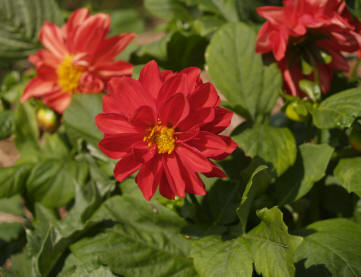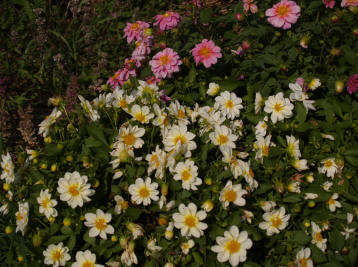Lee Royer
Frederick County Master Gardener
 Dahlias offer so much variety and versatility that almost every gardener will
find a use for them, especially in the fall garden. Hundreds of named varieties can be purchased as tubers, root cuttings or transplants. Or, as you did, they can be grown
from seed and treated as an annual; however keeping them through the winter is not much trouble, and doing so will result in quicker flowers the next year.
Dahlias offer so much variety and versatility that almost every gardener will
find a use for them, especially in the fall garden. Hundreds of named varieties can be purchased as tubers, root cuttings or transplants. Or, as you did, they can be grown
from seed and treated as an annual; however keeping them through the winter is not much trouble, and doing so will result in quicker flowers the next year.
Origin
Dahlias are the national flower of Mexico, where they are thought to have originated. In Mexico, frost is not an issue. However, in frost-prone zones
such as Frederick County, the tubers must be dug up each year and wintered in a safe place.
Digging
 The first step is to dig them up. You can dig the clumps before the frost, in which case you need to hang or lay the entire plant in a protected
ventilated area to dry slightly, allowing the nutrients to return to the roots. Or you can wait until a frost or two has 'killed the tops, but before the ground has frozen.
That way the nutrients have returned to the roots naturally and you save a step. However, knowing you may dig clumps either before or after frost allows you "a wider time
range to get the job done.
The first step is to dig them up. You can dig the clumps before the frost, in which case you need to hang or lay the entire plant in a protected
ventilated area to dry slightly, allowing the nutrients to return to the roots. Or you can wait until a frost or two has 'killed the tops, but before the ground has frozen.
That way the nutrients have returned to the roots naturally and you save a step. However, knowing you may dig clumps either before or after frost allows you "a wider time
range to get the job done.
Storage
Once the tops are dried, cut the stems from a few inches to a foot above the bulbs and place them in your storage medium. Storage media can be
vermiculite, perlite, dry sand, peat moss or layers of dry leaves. The tricky part of storage is that the bulbs must "never become wet enough to rot or be allowed to
completely dry out. Trial and error will ' be your best instructors. Try ' different options to see which works best for your situation. It could be your garage or basement
or a shed close to ' the house that stays between 35 and 45 degrees, the ideal temperature.
Be sure to label your plants clearly; so you will know 'which colors and varieties are which in the spring when you go to plant.
Winter pests
Mice find Dahlia tubers to be quite a convenient winter snack; so make sure your containers are rodent proof. A layer of hardware cloth secured over
top an otherwise sound container works well to allow ventilation and keep out the critters.
Dividing
The clumps are easiest to divide if you wait until spring when the buds (also called eyes) are more apparent. Divide your tubers into the number of
plants you want for the season. If you want many smaller plants divide them into small pieces. If you want larger but fewer plants, plant clumps without dividing intensely.
Make sure each piece contains at least one eye since that is where the new growth will emerge. If you Want a jump on the season, plant the tubers in pots a few weeks before
the last frost date but pots must he large enough to hold the roots and shoots comfortably.
 Replanting
Replanting
After all danger of frost has passed, replant your tubers according to size. Large dahlias should be planted 6 to 8 inches deep; shorter varieties, 2
to 3 inches plant the tubers in pots a few deep. At the bottom of the hole, sprinkle a little bulb fertilizer or compost, then set the tuber with bud or sprouts facing upward
and cover with soil. Space plants apart accordingly: large ones 3 to 4 feet apart, smaller ones 8 to 12 inches apart.
Tall dahlias should be staked, and now is the best time to insert stakes so you will not damage the tubers later.
More about dahlias
Visit The American Dahlia Society's Web site at wwvi.dahlia.org for more information on dahlias and to view the many varieties they have classified.
Read other articles on plants and gardens
Read other fall related gardening articles